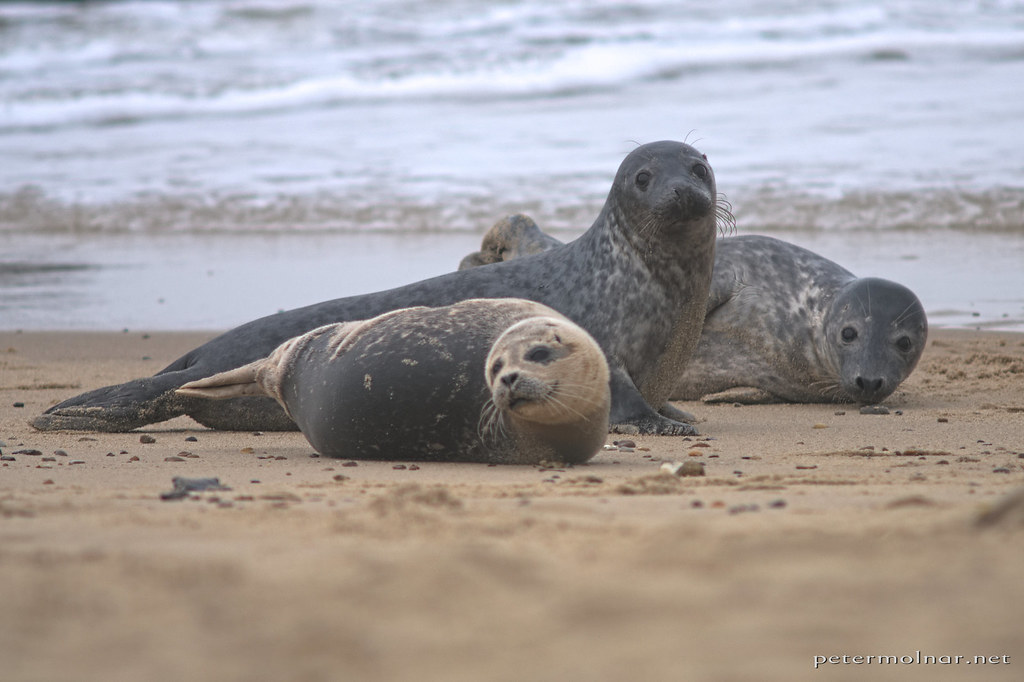
Seals in Norfolk – baby seal nursery by petermolnaret from flickr. CC BY-NC-ND 2.0
There are many different types of seals around the world, most carnivorous and their habitats shrinking because of global warming.
"Many researchers believe that there are many species that have died off in the past. However, there is still a great deal of research that has to be done in that field. One of the most common types of seals is the gray seal. There are more of them than any other, and their numbers continue to increase annually. However, there are many other species of seals that are in jeopardy of extinction.There are many different reasons for such a decline in the number of seals found in the world. One that was quite significant occurred in 1988. A type of distemper virus quickly spread among them and that resulted in the death of 1/3 of all common seals residing within the North Sea. You will find that seals live from the coldest polar regions to the very warm climates around California. From Seal-World."
Harp seals spend relatively little time on land and prefer to swim in the North Atlantic and Arctic Oceans. These sleek swimmers cruise the chilly waters and feed on fish and crustaceans. They can remain submerged for up to 15 minutes. Harp seals are sometimes called saddleback seals because of the dark, saddlelike marking on the back and sides of their light yellow or gray bodies.
Harp seals are foraging predators that eat several dozen species of bony fishes and invertebrates. They will eat just about anything they can catch. Juveniles eat krill and other pelagic crustaceans, and the diet diversifies as they grow. Adult harp seals are eaten by killer whales and large sharks. Juveniles are eaten by polar bears and other terrestrial predators, including foxes and wolves.
During the breeding season, which takes place in the spring, spotted seals are to be found at the southern edges of the pack ice, dependent on openings between ice floes for access to air and the ice surface. Known breeding areas are in the Bering Sea, Okhotsk Sea, Sea of Japan and Bohai Sea (where some seals give birth on land). Groups of three seals are often seen together on the ice in the early spring, consisting of a female, her mate and her new pup from her mate of last season. It is thought that the male joins the female about 10 days before she gives birth and mates with her, probably underwater, after her pup is born. Pups are born from February to May, depending on location, with a woolly white coat. The pup moults this coat after 4-6 weeks (2-3 weeks in Japan) at about the time that it is weaned. The pup usually stays out of the water for the first few weeks. However if it is forced to then it is able to swim, not too well, during this period. A month after it has weaned, the pup is able to dive to depths of at least 80m in order to feed.
Spotted seals gather in late spring-summer among the ice remnants, sometimes on land when ice is unavailable, to moult. There is a large variation in the colour of the adult spotted seal coat but generally it is silvery-grey with dark grey on the back and covered with brown to black spots. In the summer the seals move to the coasts as the sea ice retreats. Spotted seals in the Okhotsk Sea and Bering Seas disperse in all directions, some up to the Beaufort and Chukchi Seas, while in the Bohai Sea the migration is to the south and east. Not much is known of the distribution and movements of spotted seals during the autumn and winter months, but it is thought that they might stay in the water during this period.
